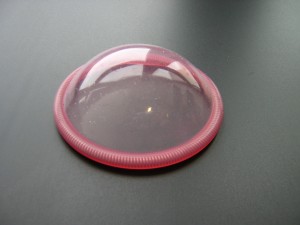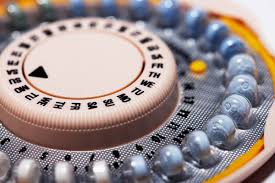Barrier Methods
Condom

No glove, no love! Wrap it up, before it gets rough! When you’re with your lover, use a rubber! Show you love her by using a rubber! You need a shield if you’re slaying a dragon! The Glove that is essential to many for love has been around for centuries Of course all of these slogans are about none other than the good, old condom. Unlike most other forms of birth control, condoms offer both protection against pregnancy and sexually transmitted diseases.
How to use
- Check to make sure the condom is not expired, brittle, open, or torn.
- Carefully remove from wrapper, being sure not to rip the condom.
- If not lubricated, place a few drops of lube on the inside of the condom. (The part that rolls down onto the penis)
- If uncircumcised, pull back the foreskin.
- Place the condom on the tip of the erect penis, with one hand pinch a half an inch of space to collect semen. With the other hand roll the condom down the shaft.
- Make sure there is no air trapped inside the condom, as this could cause breakage.
- Roll the condom down to the base of penis and lubricate the outside of the condom before engaging in intercourse.
Removing and Disposing a condom
- Carefully pull out while holding the base if of the condom to prevent any semenfrom spilling.
- Don’t spill the semen, hold the condom at the base when removing it from the vagina.
- Check to make sure it is not ripped. If its ripped, consider emergency contraception.
- Tie the end of the condom with a knot.
- Throw it in the trash – not in the toilet.
- Wash the penis with soap and water before further play.
ONLY USE ONE CONDOM AT A TIME
If condom breaks – sh*! happens. You still have options to prevent pregnancy. Consider emergency contraception immediately.
Different Methods to Using a Condom
- Can include condom placement during sex play
- Can be used for oral, vaginal, and anal sex
- Partner can place condom on other partner
- Flavored Condoms
- Latex vs. Silicone plastic
- Lambskin Condoms (Pregnancy protection only)
Side Effects
- Very few side effects. Almost everyone can use a condom safely.
- If you are allergic to latex, you can use a plastic silicone condom or a plastic female condom.
- Lambskin condoms can also be used, but they do not offer protection from STI’s.
Note to Self
- Using a condom correctly can take practice – so practice away 🙂
- Condoms are the most inexpensive option. Condoms can cost $1 and many times you can get them free.
- Finding proper sized condoms will make the experience safer and better for all parties involved.
- Lubricant can be used to enhance the sexual experience, however water-based lubricants are safest to female and male partners.
- Always be aware that certain lubricants are not safe to use with condoms.
Female Condom

The Female Condom has all the benefits of the “male” condom but with a female powered attitude.
How to use
Female Condoms take a little practice
- Remove condom from packaging, careful not rip or damage condom.
- Put spermicide or lubricant on the outside of the closed end of the female condom
- Find a comfortable position: sit, stand, squat, place a leg on a chair, lie down, etc.
- Squeeze the sides of the inner ring of the closed side of the female condom
- Insert into the vagina as if it were a tampon
- Push the inner ring as far as it can go, until it reaches the cervix
- Pull your finger out and the outer ring should hang about an inch out of the vagina
You can use the same instructions for anal sex, as well
Side Effects
May cause irritation to vulva, penis, or anus
Dulled sensation
Penis may slip between female condom and vaginal wall
Note to Self
The female condom is the only female-initiated prevention product that provides simultaneous protection against STIs, including HIV, and unintended pregnancy.
DON’T USE FEMALE CONDOM AND MALE CONDOM AT SAME TIME. FRICTION CAUSES BREAKAGE.
Cervical Cap

FemCap – sounds like a new fashion style? The cervical cap is a silicone cap that is inserted into the vagina and cover the cervix. In the United States, there is only one cervical cap method available called Femcap. The cervical cap blocks the opening of the uterus.
The cervical cap is most effective for women that have not given birth.
Of 100 women who use the cervical cap always, 14 to 29 will become pregnant. To increase effectiveness use the cervical cap with a condom or pull out before ejaculation.
How to use
- Wash your hands.
- Put 1 tsp of spermicide on the dome and spread it all over the brim. Put another tsp of spermicide on the folded area between the brim and the dome.
- Find a comfortable position. With your middle finger, find your cervix, so you will know where it goes.
- Separate the lips of the vagina and slide the cervical cap dome-side down into the vagina, with the long brim entering first.
- Push down toward your anus, then up and onto your cervix. Make sure your cervix is totally covered.
To remove the cervical cap:
- With your finger get a hold of the removal strap, and rotate the cap.
- Push on the dome a bit with your finger to break the suction.
- Hook your finger under the strap and pull the cap out.
Side Effects
The Cap will not protect against STI’s or HIV infections.
Some women develop vaginal irritation. This can be a sign of an allergy to the spermicide. If you have a mild reaction to spermicide, try switching brands to clear up the problem.
Serious but less likely side effects.
Check with your healthcare provider if you:
- feel a burning sensation while urinating
- are uncomfortable when the cervical cap is in place
- feel irritation or itching in the genital area, have unusual discharge from the vagina.
These symptoms may be a sign of infection or other condition.
Note to Self
One Cervical Cap can last you up to two years. It cost on average from $60 to $75. Spermicidal jelly or cream costs about $8 to $17 a kit.
Diaphragm

A Diaphragm is a shallow silicone cup inserted into the vagina. Similar to the cervical cap, it must be used with spermicide. It blocks the opening of the cervix and prevents sperm from entering. Once inserted it should stay in place for more than six hours.
Effectiveness **3 of 5
Out of 100 women who always use the diaphragm, between 6 to 16 will become pregnant.
How To Use
- Wash your hands.
- Check the diaphragm for any holes.
- Put 1 tsp of spermicide in the cup and around the rim.
- Find a comfortable position.
- Separate the lips of your vagina with one hand, and use the other hand to pinch the rim of the diaphragm and fold it in half.
- Put your index finger in the middle of the fold to get a good, firm grip.
- Push the diaphragm up and back into your vagina.
- Make sure to cover your cervix.
To REMOVE it:
- Wash your hands again. With your index finger, hook it over the top of the rim of the diaphragm and pull the diaphragm down and out.
- After you take it out, wash it with mild soap and warm water. Let it air dry. And use it again.
Side Effects
The Diaphragm will not protect against STI’s or HIV infections.
Some women develop vaginal irritation. This can be a sign of an allergy to the spermicide. If you have a mild reaction to spermicide, try switching brands to clear up the problem.
Serious but less likely side effects. Check with your healthcare provider if you: feel a burning sensation while urinating, are uncomfortable when the diaphragm is in place, feel irritation or itching in the genital area, have unusual discharge from the vagina. These symptoms may be a sign of infection or other condition.
Notes to Self
Does not protect against STI’s or HIV infections.
It is hormone free.
There come in latex or silicone. If you are allergic to latex, make sure to get the plastic silicone version.
Costs about $15–$75 and last up to 2 years.
Spermicide

Here is a very inexpensive option. However, it is best to combine with other birth control options for super, duper, über protection! Spermicide come as creams, films, foams, gel and suppositories placed in the vagina.
Spermicide contains chemicals that stop sperm from moving, therefore keeping sperm from joining the egg.
If always used as directed, 15 out of 100 will become pregnant.
How To Use
Find a comfortable position and gently insert the spermicide into vagina. Wait 10 minutes before intercource. Make sure the spermicide is deep in the vagina. Insert more spermicide each time you have vaginal intercourse.
Side Effects
No protection for STI or HIV infection.
Can be messy.
Irritation to vagina or penis. If this is the case, consider changing the brand.
Note to Self
Easy to use, but not highly effective.
Can make you more susceptible to viruses if spermicide irrates sensitive skin.
Costs about $8 per package.
Hormonal Contraception
- Emergency Contraception aka Plan B
- The Patch
- Implant
- The Shot
- IUC’s – or the device formerly know as IUD’s
- The Pill
Emergency Contraception aka Plan B

So that happened, and your birth control kind of, well, didn’t. Whether you notice that the condom tore or you forgot to take the Pill this morning, or you got caught up in the moment, EC is a great back up method. EC stops pregnancy before it starts.
EMERGENCY CONTRACEPTION (EC) can be taken up to 5 days (or 120 hours) after unprotected sex.
Plan B One-Step EC brand is available without age restrictions to women and men. That means that you do not need a prescription. Just go to your local pharmacy ( in most states) and get Plan B One-Step over-the-counter – no matter your age. If they do not carry it or you come up against some other unforseen question, visit http://eclocator.not-2-late.com/search.asp to find a retailer closest to you.
How to use
Levonogestrel pills, including the brands Plan B One-Step and Next Choice One Dose, are up to 89 percent effective when taken within 72 hours (three days) after unprotected sex and continue to provide protection up to 120 hours.
Another Brand, Ella, is 85 percent effective if taken within 120 hours (five days).
Pregnancy doesn’t happen right after sex. You can prevent pregnancy even after sex. It can take up to six days for the sperm and egg to meet after having sex. EC works by keeping a woman’s ovary from releasing an egg for longer than usual. Pregnancy cannot happen if there is no egg to join with sperm.
Take EC as soon as possible after unprotected sex. For EC to be most effective, take it up to 120 hours (five days) after unprotected intercourse.
Side Effects
There are no reports of serious side effects. Because EC is a hormonal form of birth control, possible side effects may include: an earlier or later, heavier or lighter period than usual, breast tenderness, dizziness, or headaches, and nausea or vomiting. If you vomit within two hours of taking the pill(s), it won’t be effective and you need to take it again.
Note to Self
You DO NOT need a prescription to get Plan B One Step EC. Costs vary from $30 to $65
Does not protect against STI or HIV.
The ParaGard IUD can also be used as emergency birth control, to prevent pregnancy after unprotected intercourse. It can reduce the risk of pregnancy by 99.9 percent if inserted within 120 hours (five days) after unprotected intercourse. Cost can run up to $900 for IUD insertion, however most health plans cover this form of birth control.
The Patch

It is a thin, beige, plastic patch that you can place any where on your body. It lasts a one week. It is known as Ortho Evra. The Patch releases the same hormones as The Pill — estrogen and progestin. These hormones prevent pregnancy by keeping eggs from leaving the ovaries and making cervical mucus thicker.
When always used as directed it is 99% effective.
How It Works
Get a prescription from your healthcare provider. Most often, women start using the ring within the first five days after the start of their periods.
Stick the patch on your body. Most common places are the skin of your buttocks, stomach, upper outer arm, or back. Wear the patch for three weeks, remove it on the fourth and stick on a new one the following week.
Side Effects
Serious side effects of the birth control patch, though rare, may be more likely if you have certain conditions. Some of these conditions may even rule out using the patch.
You should not use the patch during prolonged bed rest or if you
- are pregnant
- get migraine headaches with aura
- have certain inherited blood-clotting disorders
- have had blood clots or vein inflammation
- have had breast or liver cancer
- have had a heart attack, stroke, or angina
- have had serious heart valve problems
- have lupus with certain conditions
- have serious liver disease
- have uncontrolled high blood pressure
- have very bad diabetes
- smoke and are 35 or older
- smoke and have high blood pressure
If you have a condition that makes it unsafe to use the patch, don’t worry. There are many other methods of birth control that may be safe for you if you cannot use it.
Note to Self
Costs about $15–$80 a month.
If the patch falls off or you miss a day or two, immediately put on a new patch. Use a back-up birth control for the next 7 days.
Implant

Sounds a little creepy at first, but imagine 3 years of continuous birth control.
Less than 1 out of 100 women a year will become pregnant using the implant.
There are some benefits to long-term birth control. The ability to get pregnant, if you desire, returns quickly once you stop using the implant. You can using while breastfeeding. If you can not take estrogen, this is a good option. You dont have to remember to take medicine every day.
How to Use
The implant is matchstick sized implant that is inserted into your arm. It last 3 years. It must be performed by a healthcare professional. The birth control implant releases a hormone – progestin- to prevent pregnancy. Progestin keeps eggs from leaving the ovaries – so no egg joins the sperm. It also makes the cervical mucus thicker, keeping sperm from getting to the eggs.
Side Effects
Like with any form of long-term birth control there are side effects. The most common is irregular bleeds, especially during the first -12 months. For most women, periods become fewer and lighter. After one year, 1 out of 3 women who use the birth control implant will stop having periods completely. Some women have longer, heavier periods. Some women have increased spotting and light bleeding between periods.
Less Common side effects: change in sex drive, discoloring or scarring of the skin over the implant, headache, rarely, an infection or pain in the arm, nausea, pain at the insertion site, sore breasts and weight gain.
Note to Self
The Implant can be removed at any time.
The cost of the exam, the implant, and insertion ranges from $400–$800. Removal costs between $100 and $300.
The Shot

Depo Shot, aka, Depo-Provera aka the shot is an injection of a hormone – progestin- to prevent pregnancy. Progestin keeps eggs from leaving the ovaries – so no egg joins the sperm. It also makes the cervical mucus thicker, keeping sperm from getting to the eggs. Simply put it’s a shot that goes in your arm or butt cheek and it give you 3 months of pregnancy prevention!
The shot is very effective when used correctly. Remember you need to get a new shot every 12 weeks. If used always, the Shot is 99% effective.
How It Works
Visit your healthcare provider. They will administer the shot.
Side Effects
No protection against STI’s or HIV infections.
Irregular bleeding can occur, especially in the first 6 to 12 months of use.
Because this is a hormonal birth control option, your period may vary. For most women, periods become fewer and lighter. After one year, half of the women who use the birth control shot will stop having periods completely.
Some women have longer, heavier periods.
Some women have increased spotting and light bleeding between periods.
Less common side effects: change in sex drive, change in appetite or weight gain, depression, hair loss or increased hair on the face or body, headache, nausea, and sore breasts.
Note to Self
Because Depo is an injection, any side effects may persist until the shot wears off at 12-14 weeks.
Ask your your healthcare provider about calcium or Vitamin D to keep your bones healthy.
IUC’s – or the device formerly know as IUD’s

Wait they go where!? Oh but they last how long!? Okay, okay…It’s that little “T”, right?
Less than 1% of women who use IUC’s experience pregnancy each year. Very effective.
How to Use
Intrauterine Contraceptives (IUC) or Intrauterine Devices (IUD) are small “t”-shape plastic devices that are places in the cervix.
There are two types of IUC’s.
- Copper ( ParaGard) lasts 12 years.
- Hormonal: Mirena lasts for 5 years and Skyla lasts for 3 years.
After they are medically inserted, IUC’s work by blocking the sperm and egg from joining together, therefore preventing pregnancy. Some IUC’s work by releasing low levels of Progestin which further prevent pregnancy by increasing the thickness and quantity of cervical mucus, which helps stop sperm.
Side Effects
IUC do not protect against STI’s or HIV infections.
When placed, IUC’s may cause slight pain
Cramping or backache for a few days and can last longer
Spotting between periods for a few months
Irregular periods
Worse menstrual cramps and heavier periods
Serious but less likely side effects: Displacement or falling out of IUC; development of infection; IUC could push through the wall of the uterus and cause problems in other parts of the body.
If you get pregnant while using IUC, remove the device.
Note to Self
IUC’s do not protect against STI’s
They are useful for long term birth control.
Can help with being sexually spontaneous.
Did you know that you can take out your IUC on your own?
The Pill

So the old classic form of birth control “The Pill. Been around for ages, but has gone through several changes to make it safer for women.
Is there just one pill, or are there different types? Are there any side effects? Did you know that the pill can do more than just prevent pregnancy?
The Pill is a medication to prevent pregnancy. The Pill contain hormones – either estrogen and progestin (combination) or just progestin – that you can take either every day for a 21 day period, with one week off (to have your period).
Depending on the type of pill, you should take the pill daily, at the same time each day, to ensure maximum protection.
With Progestin only pills, you may only get your period on the fourth week, stop getting your period, or have spot bleeding throughout the month.
How to Use
After just starting either the combination pill or the progestin only pill, you should use other birth control for the first week.
You can start either type of pill at anytime (except during pregnancy).
Side Effects
The pills do not protect against STI’s or HIV infection.
Common side effects: bleeding between periods (mostly progestin-only), tenderness in the breasts, nausea and vomiting, hormones may change a woman’s sex drive (libido). For some women, the hormones in pills can throw off your mood…if you’re noticing that you are not feeling yourself… think about talking to your provider about changing the hormonal amount or switching to another form of birth control.
Serious but less likely side effects: clotting, strokes, heart attacks, developing high blood pressure, liver tumors, gallstones, jaundice. Check with your physician about any health concerns.
The pill may not be as effective for women who have extra curves to love.
Note to Self
It’s important to use birth control consistently- everyday and at the same time. If you are using the pill, leave in a place you see everyday about the same time to make sure you take it on time. For example put it in the cabinet with your toothbrush or by your alarm clock/cell phone charger.
Cost about $15–$50 each month
There is little link between the pill and breast cancer, DON’T believe the rumors.
The Pill can be a private form of birth control.
Natural Contraception Methods
Natural Rhythm

It’s just natural, right? The Church is cool with it, right? It’s intimate and cool for both of you, right? As long as I know my cycle and I am super regular, I can control my fertility, right?
24% of couples who do not use all Fertility Awareness Methods correctly get pregnant each year.
In other words, in order for Fertility Awareness Methods to be effective in pregnancy prevention, all methods need to be used always and correctly.
Effectiveness is based on the individual and the couple.
How To Use
Also called Fertility Awareness-Based Methods
By knowing a woman’s personal menstrual cycle, she and her partner can abstain from vaginal sexual activity (or use other contraceptives) on the days before her ovulation, which are her most fertile days
If a woman knows on what days she is most fertile, she can plan to avoid vaginal sex and reduce her risk of pregnancy.
There are a couple of different methods including, the Temperature Method (Checking your temperature every morning); Cervical Mucus Method (checking changes in cervical mucus everyday, until you are sure you are ovulating); Calendar method (marking ovulation on the calendar)
Using all 3 methods, may be the most effective choice to keep track of your cycle, and is called the Symptothermal Method
Standard Method Days are the days which after tracking your cycle for several months and making sure it is between 26 and 32 days long, having vaginal intercourse on days 8-19.
Side Effects
No side effects to tracking your cycle.
There is not protection for STI’s.
Note to Self
No hormones.
It’s a lot of work and may not always be reliable, but matching this method with other methods of birth control may be the best for you.
Withdraw

They used to call it ‘spillin’ your seed’…now we call it ‘pullin’ out’. Whatever you call it this is one of the most difficult and ineffective methods of birth control.
Before the man ejaculates in the woman’s vagina, he pulls out and ejaculates outside of the vagina, the farther the better.
Be aware that the penis can release semen even before ejaculation – so you have to pull out.
‘Pull out’ does not protect against STI’s. Doesn’t take into account getting caught up in the moment and forgetting.
Requires high level of comfort and knowledge of your arousal level to prevent any fluid from entering the vagina. However could be used in combination with the pill and condoms. Also this is a purely male controlled type of birth control.
